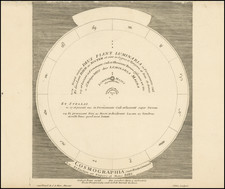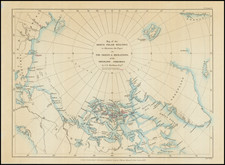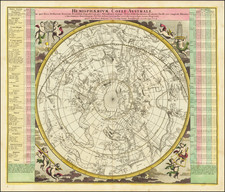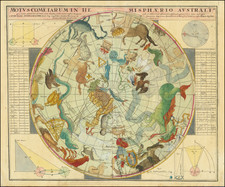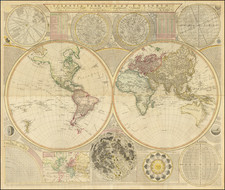A View of The Constellations From Beyond Our Universe
Cellariuis's stunning projection of the Southern Hemispheric skies, depicted in a novel format in which the constellations are superimposed over the globe, from Andrea Cellarius's Harmonia Cosmograhpica, considered the greatest celestial atlas ever published.
This unusual celestial perspective, which Cellarius termed "scenographic," shows the celestial sky as if seen from the firmament (above the stars themselves), a sort of god's eye view of the constellations, looking toward earth. In the views, each constellations is a mirror image of the way each constellation would be seen from earth. This projection reflects a theory that originated with Petrus Plancius that the stars remained in a sphere-like configuration above the earth and moved in coordination with the earth.
Cellarius produced a total of four scenographic projections. Two of them, presented here, focus on the constellations and show a diminished globe, while the other two show transparent constellations and instead focus to a larger extent on the terrestrial/geographical details below the stars. Here, the Southern Hemisphere projection is centered on the "Terra Australis Incognita," a representation of the unknown great southern continent. The Northern Hemisphere projection shows the European and Asian continents.
The stars in the Southern Hemisphere plate show thirteen newly of the newly-discovered constellations that can be seen solely from the Southern Hemisphere, which were laid out by Petrus Plancius between 1592 and '98. Many of them are given names that correspond to animals that inhabit regions recently explored by Europeans, such as Pavo (the peacock) and the Pis Indica (apparently the turkey).
Next to the scenographs are images of scientists and scholars using telescopes and other instruments meant for studying the stars. As with much of the imagery in the Harmonia Macrocosmica, the images in the borders are derived from earlier celestial books. Here the groups of astronomers are copied from two almost identical scenes in Johannes Hevelius's 1647 Selenographia sive lunae descriptio.
This is a truly spectacular example of this decorative mapping of the southern skies.
Andreas Cellarius was born in 1596 in Neuhausen and educated in Heidelberg. He emigrated to Holland in the early 17th century, and in 1637 moved to Hoorn, where he became the rector of the Latin School. Cellarius' best-known work is his Harmonia Macrocosmica, first issued in 1660 by Jan Jansson, as a supplement to Jansson's Atlas Novus. The work consists of a series of Celestial Charts begun by Cellarius in 1647 and intended as part of a two-volume treatise on cosmography, which was never issued.









